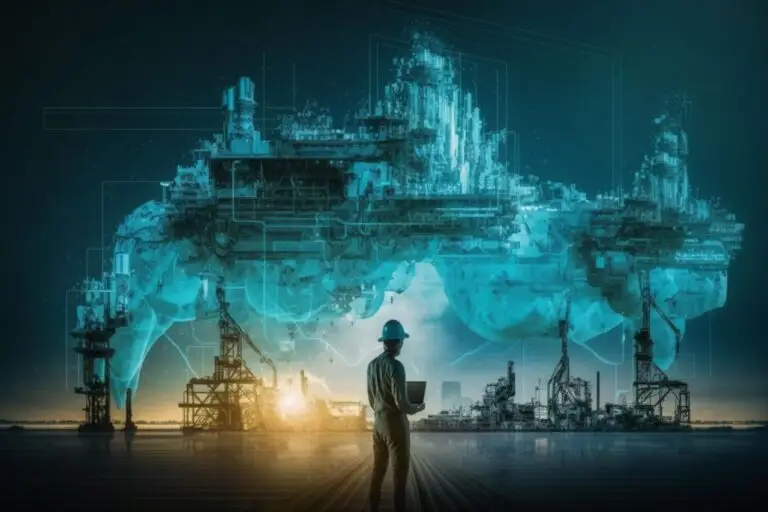
Global Energy Trends and the Evolving Role of Generative AI in Oil and Gas
The quest to curb energy consumption is a global challenge, with industries worldwide grappling to balance demand and sustainability. Following a brief 4.5% dip due to the COVID-19 pandemic, global energy usage is resurging, marked by a notable 5% increase. Projections indicate a continuous rise in global energy consumption, expected to grow annually by 1 to 2%.
How can we diversify energy solutions to meet the growing demands of the future?
The focus isn’t just on reducing energy demand but also on pioneering optimized and varied energy sources. The US Energy Information Administration (EIA) forecasts that by 2050, power generation will reach nearly 45 trillion kilowatt-hours (kWh), up by almost 20 trillion kWh from 2018. This upswing in energy generation amplifies the pressure on key sectors, particularly Oil and Gas, to revamp their business models and adopt decarbonization practices.
The oil and gas industry embarks on a transformative journey, steering towards sustainable practices in a bid to reshape its environmental footprint.
This transition heralds a new wave of sustainable innovation in oil and gas operations. Companies are now incorporating environmental management as a core aspect of their business strategies, in addition to the traditional pillars of exploration, production, transportation, and distribution. A critical element in this transformation is the adoption of generative AI (GenAI), which aims to enhance efficiency, profitability, and sustainability.
Mixed Reactions Towards GenAI in the Oil and Gas Sector
The reception of GenAI within the oil and gas industry is varied. The technology sector is optimistic about its potential, while end-user organizations in oil and gas exhibit caution. IDC’s Future Enterprise Resilience and Spending Survey Wave 2 (March 2023) indicates that a mere 18% of oil and gas companies globally are poised to invest in GenAI this year, with the majority still evaluating its applicability.
Potential GenAI Applications in Oil and Gas
- Asset Operations: GenAI is adept at generating new data, enhancing simulations, and boosting predictive capabilities for operational assets. This includes digital twins, predictive maintenance, and automation of asset-management workflows.
- Upstream Subsurface Data Analysis: Enhancing images to create detailed 3D models and generating subsurface images with limited seismic data scans are among GenAI’s capabilities, addressing upstream data acquisition challenges.
- Enterprise ChatGPT for Business Leaders: Utilizing the vast unstructured data in oil and gas, GenAI facilitates access to crucial information, aiding leadership in decision-making processes. Large language models (LLMs) like ChatGPT are instrumental in generating text, answering specific questions, and functioning as chatbots and virtual assistants.
Integrating Generative AI in Oil and Gas: A Shift from Tradition
From Manual Analysis to Strategic Alignment with GenAI
Traditional approaches in oil and gas often relied on manual data analysis, which, while thorough, was time-consuming and prone to human error. The integration of GenAI represents a paradigm shift, automating and enhancing data analysis and decision-making processes. As the saying goes, “Change is the only constant in life.” This aptly applies to the industry’s transition to GenAI, requiring a strategic alignment that encompasses identifying key areas for its application and ensuring it supports overall business objectives.
Data Handling: Past and Present
Previously, data management in oil and gas was fragmented and often lacked the sophistication needed for complex analysis. With GenAI, the demand for robust data infrastructure becomes imperative. It’s akin to the difference between using a map and a GPS; GenAI, like the GPS, requires a more advanced, integrated system to navigate the vast data landscape effectively.
Workforce Evolution
The industry’s workforce has traditionally been grounded in specific domain knowledge. The advent of GenAI necessitates a blend of old and new, combining traditional expertise with advanced tech know-how. There’s a relevant proverb: “To sharpen an iron tool, you need something as hard as iron.” Similarly, to harness GenAI’s capabilities, the industry needs a workforce skilled in these advanced technologies.
Pilot Projects: The Bridge Between Old and New
In the past, new technologies in oil and gas were often deployed on a wide scale after extensive theoretical research. GenAI changes this approach. Pilot projects for GenAI provide tangible proof of its benefits and challenges, allowing for real-time adjustments before full-scale implementation.
The Uncertain Road Ahead
The integration of GenAI in oil and gas is not without its challenges. Concerns include the development of regulatory frameworks and data security issues. Additionally, as these companies strive to improve their ESG performance and commit to net-zero emissions, the environmental impact of GenAI technologies is under scrutiny.
The carbon footprint of training AI models is a significant concern, with emissions rivaling those of automobiles over their lifetimes.

IT Vizion is the OT/IT system integrator of choice for some of the largest Oil&Gas, Chemicals, and Manufacturing companies worldwide.
Copyright ©2025 IT Vizion
Contact info
Let’s connect. Contact IT Vizion today.
- We Operate Worldwide
- +1 (951) 256-4320
- [email protected]
